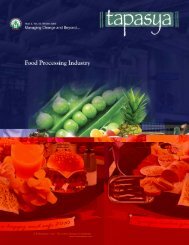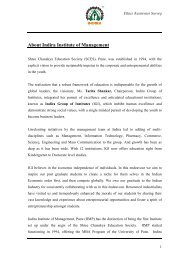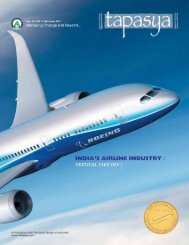IMR JAN 2013 - Indira Institutes
IMR JAN 2013 - Indira Institutes
IMR JAN 2013 - Indira Institutes
You also want an ePaper? Increase the reach of your titles
YUMPU automatically turns print PDFs into web optimized ePapers that Google loves.
Changing Consumer Attitudes Among WomenHeath(2007).Attitude differ by the way theyserve in terms of the functions. Consumerswho differ on certain traits will exhibitcorresponding differences in attitudefunctions(Bazzini and Shaffer 1995,Debono1987,Lavine and Snyder 1996,Petty andWegener 1998).Some of the products servespecific attitude functions, viz., attitudetowards Toothpaste, Cough syrup etc., basedon utilitarian function (Shavitt1990,Shavitt,Lowrey and Han 1992) and otherproducts like Flags,Rings serving symbolicfunction(Shavitt,Lowrey and Han1992);however attitudes can serve morethan one function for products likesunglasses, motor cars etc(Shavitt, Lowreyand Han 1992).The understanding of theattitude functions serve the knowledge tochange the attitudes, to tune theappeals/arguments to match the attitudefunctions. This function matching is wellresearched in the past(Claryetal.1994;Bazzini and Shaffer1995;Murray,Haddock and Zanna1996;Lavine and Snyder 1996;and Petty andWegener 1998).Both utilitarian andsymbolic appeals influence consumersattitude to different products/brandscategories(Lutz 1981,Shavitt,Lowrey andHan 1992).Research into the role ofemotions/affect in shopping areavailable(Rayand Walker, 2004;Spears,2005). As per Duncan(2005)Consumer motive is the internal impulseswhich when stimulated initiate someresponse, as consumers are continuouslyreacting to their internal impulses as well asexternal environment. Kim and Jim(2001)stated that consumer motives are drivers ofbehavior that bring the consumers to theshop for purchase. Tauber(1972)propounded that consumers were oftenmotivated by many personal and socialfactors actually unrelated to the need forbuying/consuming products/services. Thereexist ulterior motives which reflect in theattitude.T he information seeking functionas per Tauber encompassed informationsearch, comparison and analysis.Nonetheless impulsive buying has beenevidenced driven by hidden forces like socialinteraction/reference group affiliation/peerpressure/social comparison etc. Thompsonetal.(1990) observed that both hedonic andutilitarian functions coexisted amongconsumers, and one mode tended todominate in some consumer segments.Numerous research focusing on the feelingsof mastery experienced/feeling ofexpression of ego or obtain satisfaction of agood deal in shopping are available( Feickand Price,1987;Lichtenstein etal.,1990;Schindler,1989;Slama andWilliams,1990).Also Tauber (1972),Rohmand Swaminathan(2004) identified buyingmotives that fetch enjoyment as a leisureactivity for the consumer.Consumer maydesire to seek higher level of experientialconsumption relative to utilitarianconsumption(Kim,2001).Positive emotionsof the consumers are significantdeterminants in buying behavior like thepatronage benefits, excitement on outing,time/money spend on valued priorities, asper the study of Kim etal.(2002) on apparelson utilitarian versus hedonic functions ofattitude. Haanpa(2005) made a study on thedifferent shopping motives of consumers inFinland on experiential and gratificationfactors, Hedonic/Recreational, Economicand Convenience types with the youngerones cherishing enjoyment on social andemotional front.Parsons(2002) put forththat in inline buying, the driving forces are34 <strong>Indira</strong> Management Review - Jan <strong>2013</strong>








